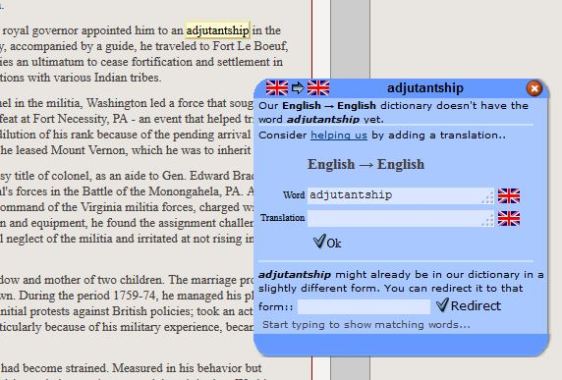I was preparing for today’s English class and was planning to make a mind map on the smartboard. The problem is that it is difficult to write small enough with the fat pencils… I looked for mind map tools online, and there were many to choose from. I wanted one without registration, and came across MindMup. Genious! Once you’ve finished your mind map, you can either save it on Google drive, publish it publicly, or make a pdf. The pdf-link lasts 24 hours, but hey, that’s plenty of time to download it and save it for later 🙂
Remove webpage pictures and read text only
I read an interesting article in Technofil, where it says that dyslexics learn more from reading text only.
Open the webpage through the free tool Readability to remove pictures 🙂
Web 2.0 publishing tools
Lingro website dictionary
It’s sometimes difficult to understand all words in an English text. Both for students and for teachers 🙂 By opening the website through the webtool Lingro, all words in the text become clickable for translation.
This image is a snip from a text about George Washington, found at the National Archives in USA. You can choose from a number of dictionaries at Lingro, but not Norwegian. Swedish might work for some, but I actually think that looking up an English word in an English-English dictionary is better than an English-Norwegian one. By reading English definitions, the students practise their understanding of the English language.
Well, Lingro definitely has something to it, but it’s still not perfect:
To Lingro’s defence, adjutantship wasn’t in the dictionaries Merriam-Webster, Oxford or Cambridge either. Curious? The word means the state of being an adjutant, but I guess you knew that 🙂
Authenic language interaction
This is brilliant! Students in Brazil chat with seniors in America for language learning purposes. A win-win situation for the students who want to practise their English and for the retired Americans who would like someone to talk to.
Mandatory blog entries
An inspiring semester is coming to an end. The final post on my part is a survey of the blog entries connected to the mandatory topics:
- Electronic Portfolios as Knowledge Builders
- Personal-Educational Digital Storytelling (EDS) and Digital Storytelling
- Does the internet disturb the memory storage? and Hypertext
- Crap Detection Literacy and Creating accounts at websites
Since this blog is also my digital archive, there might pop up some digital inspirations occasionally in the future. To my peers: good luck putting this course’s reflections and tools into practise in your profession 🙂
Assessment and digital texts
I enjoy a good cup of tea. This is no commercial, but the Yogi tea bags have words of wisdom attached. This is what I read the other day: Only he who knows the destination, knows the way.
I once asked my upper secondary students at the beginning of a new school year who they thought provided the guidelines for the various subjects. They suggested their parents, the local authorities, the school administration and the teachers. I was surprised to hear that they didn’t know about the subject curricula given by the The Norwegian Directorate for Education and Training.
The destination of education is knowledge. The teacher knows both the destination and the way to get there. It’s his/her job to interpret the curriculum and guide the students along the way. The Knowledge Promotion Reform presented in 2006 incorporated the ability to use digital tools as a basic skill. Even though this skill is interdisciplinary, it’s embedded in the competence aims of all subjects. In the English Subject Curriculum, it says that the students should know how to:
- use digital tools to find information and create text (after year 4)
- use digital tools to find information and to prepare texts (after year 7)
- communicate via digital media (after year 10)
- produce composite texts using digital media (after vg1 – programmes for general studies)
Well, back to the destination, knowledge. A.k.a competence. How do we ensure that the students reach it? Through formative assessment. Dylan William (What is assessment for learning?) cites the Assessment Reform Group (Broadfoot et al, 1999) and points out characteristics of learning-promoting assessment:
- it involves sharing learning goals with pupils
- it aims to help pupils to know and to recognise the standards that they are aiming for
- it involves both teacher and pupils reviewing and reflecting on assessment data
A well arranged assessment form divided in competence aims and further subdivisions is a useful tool when assessing. Most L2 teachers are trained in assessing a written text. I presume they’re on shaky ground when it comes to composite texts using digital media (cf competence aim after vg1). Many educators have made attempts of creating forms for this purpose. I have seen several, but not really found the perfect one. Actually, I’m not sure that the perfect one exists, or ever will. The reason is simple: each assignment should be assessed based on its expected destination. And since assignments differ, assessment should also differ.
However, here are some questions to consider when preparing the students for the assessment:
- What will be assessed? The digital skills or the digital product? Or both?
- What kind of assessment? Self-assessment? Peer-assessment? Teacher-assessment?
- Will contents and communication be equally emphasized?
It’s important for me (and for the students, presumably!) that an assessment form is lucid. Details and explanations should mostly consist of key words and not sentences. My main categories might be:
- Structure (plot, setting, continuity)
- Communication (oral, audio, rhythm)
- Layout (images, video, colors, fonts)
I prefer three coloumns for grading, and I find it important that all column names promote learning. Names like above average, average and below average do not… The names should also not be words describing personal qualities, because getting a bad grade, doesn’t necessarily mean that it’s a bad student. Everyone is entitled to bad days. I want encouraging words for the good and for the bad. The encouragements are not set yet, but they will be:-)
A nation of thieves?
Plagarize: to commit literary theft : present as new and original an idea or product derived from an existing source. – Merriam Webster dictionary
Pupils in lower secondary school steal. Students in upper secondary school steal. Students at universities steal. Even researchers steal.
Teachers act. Developers of plagiarism prevention tools act. Educational institutions act. Politicians act.
Still the problem remains unsolved. It’s not like cheating is a new invention. The digital age has just made it easier.
There are various reasons for plagiarism (being lazy, academic pressure, fear of revealing one’s inadequacy). There are also many suggested solutions to the problem
Among all the voices shouting, I’m actually more interested in the students’ perspective. A group of students from Langhaugen Upper Secondary School in Norway won a research award (Holbergprisen i skolen) in 2010 for their study on plagiarism, «The Invisible.» It’s well worth reading for teachers as well, in order to understand one’s students and actively prevent literary theft.
The bottom line of plagiarism remains: copying someone else’s work instead of doing the work on your own does not generate intellectual progress, but rather undermines learning (The Pritchard Axiom)
Commenting blog entries, part 2
I’ve previously posted a piece about theoretical framework and personal reflection regarding commenting other blogs’ entries (Commenting blog entries), pointing out how comments can add expansion of the entry’s content itself. I challenged myself to upgrade my commenting skills, since focusing on one’s own work comes much easier. Here are a couple of examples:
Lena’s blog entry Multer og multimodalitet
Hopedal’s blog entry Digital texts part 3
I discovered that it was both interesting and educational to broaden my horizon by interacting with my peers more actively. Too bad it took me so long, but it’s most certainly a great experience to bring into the classroom while working with digital tools.
As for my own blog entries, I’ve attempted to ask questions and address the reader at a greater degree. Writing this, I realize that the comments made by peers or mentors have not turned into interaction due to me not following up… Still learning 🙂
Creating accounts at websites
I have registered at numerous websites over the years. A wise user would probably make an overview to have some kind of control. I haven’t… I was scrolling through the list of web tools for creating online quizzes and polls offered by Educational Technology and Mobile Learning. Finally, I ended up clicking the link to Quibblo to check it out. The website was neat and the graphic of the various quiz generators was inviting:
So I decided to create a quiz as a test. It’s said that the best things in life are free. That does not necessarily include web tools, or does it? Sure, Quibblo offers a free registration. But is it really? The registration page looked like this:
Instead of paying with money, you are asked to specify quite a lot of information about yourself. I never register when I’m asked to reveal personal information such as birth date. I’m also reticent to connect via a social media account, because that would open up to even more personal information about me.
Since I would normally register with Email address and username/password, I usually don’t read the terms and conditions too well… I know 😦 Well, this time I was curious. Here are some things I would have agreed to by registering:
This Policy may change from time to time. Please check back frequently for updates. Seriously? Who would check back on the privacy policy later? I know I wouldn’t… Once the terms are accepted, they would rather fade into oblivion, and the tool itself is the main issue.
In a User Form, Quibblo or a third party may offer you incentives in exchange for providing information about yourself such as name, email address, street address, zip code, telephone numbers, birth date, gender, salary range, education and marital status, occupation, employment information, and personal and online interests (together, «User Information»). Completing the User Form is voluntary and you are under no obligation to provide User Information. I couldn’t get to the User Form since I didn’t register, but I suspect that there would be a link to the terms and conditions. I further suspect that they wouldn’t be read… Furthermore, this paragraph evidently shows that users are really paying even though the registration is free: the barter allows an exchange of incentives for personal information.
Information voluntarily provided to Quibblo or lawfully obtained by Quibblo is the property of Quibblo and may be used by Quibblo for any lawful purpose, including the sale, lease or transfer of the information to Publishers, advertisers and data aggregators, for marketing purposes. No wonder registration at various websites is free, they make their money by selling the users’ information. Considering this, I was curious what people were richening themselves over the lives of others. I clicked the about button, only to read the following:
Quibblo is about you. It is also about people who are similar to you and about people who are totally different. It is about friends and strangers and content and knowledge. It is a place for you to create and interact with quizzes, polls, surveys and content around the topics that are of interest to you. Test your trivia knowledge, survey your fellow web surfers for their opinions or quiz your friends to see how well they really know you.
This doesn’t really tell me any more about the website, only about the users. So I clicked contact us, to see if there would be any hints there. Instead of contact information, I was asked to fill in this form:
My final attempt was visiting the lookup database Who is. The name of the registrant of Quibblo is Director TechOps… Need I say more? Well, I suppose I should. I’m not saying that nobody should create an account at Quibblo, but they should be aware of what they are getting into. This process was an eyeopener for me, even though I think of myself as having been restrained previously also. And there are quiz generators on the internet where you don’t need to put yourself out there.







